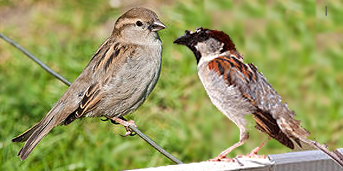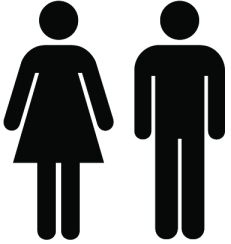A 6-year-old I know brought home a reading assignment from kindergarten. It’s called The New Nest, by Sandra Iversen, with illustrations by Peter Paul Bajer. An innocent tale of Mama Bird and Papa Bird working together to build a nest from 20 twigs, straw and wool. At the end, Mama Bird is sitting on her eggs wearing pearls. Papa Bird is in a white collar and blue tie.
It’s curious to use men’s and women’s accessories (tie, necklace) to identify the gender of the couple, when the species itself provides a reasonable degree of sexual dimorphism.
That’s seems comparable to the dimorphism found in humans.
Using both gendered clothes and bodies is not necessary, but together they are a powerful teaching tool for children, forming a lesson on the concordance of gender and sex differences: matching the different bodies with the appropriately different clothes.
This book is actually featured in a write-up on teaching reading from the journal The Reading Teacher.
I don’t know what the intentions of the article writers were, but there is nothing in there about teaching about sexual dimorphism, or gender norms and practices.
Philip N. Cohen is a professor of sociology at the University of Maryland, College Park, and writes the blog Family Inequality. You can follow him on Twitter or Facebook.




Comments 22
REAvery — April 25, 2010
I do wonder if the illustrator was simply trying to anthropomorphize the birds (and ended up gendering them as an almost-inevitable consequence of how gendered our culture is) or if they were specifically trying to gender them?
K — April 25, 2010
"I don’t know what the intentions of the article writers were"
I don't want to be presumptuous, but it looks like the article is about the stages of developing reading comprehension.
Rev. 1:16 — April 25, 2010
This is the first time I've truly not understood the point of a post here.
"It’s curious to use men’s and women’s accessories (tie, necklace) to identify the gender of the couple, when the species itself provides a reasonable degree of sexual dimorphism."
1. What a sloppy misuse of the word gender.
2. Children's characters should be easily identifiable. While you might find the degree of dimorphism reasonable, children might confuse the two.
The birds are depicted anthropomorphized as many children's book characters are. So?
Sacha — April 25, 2010
I'm going to point out something already said in This article which talked about gender exaggeration in comics. In particular, how the gender differences between animals were illustrated in cartoons. The examples are Garfield (exaggerated eyelashes and lips on Nadine) and also Minnie Mouse (again, exaggerated eyelashes). The point of this exaggeration is to illustrate the differences between male and female in animals for which there is no great degree of dimorphism.
Rev's point is valid, that children who are not too familiar with the particular species may struggle to understand which character is which; although the point that the sparrows are drawn with the correct colouration and this should serve as enough once the characters are introduced, is also true. I wouldn't expect a book about mallards to need to have a high heeled duck in order to illustrate who mummy duck is.
Grafton — April 25, 2010
The duck conversation is comical. The birds in the book are Passer domesticus, the most widely distributed species of bird in the world, very clearly sexually dimorphic in their markings and strongly associated with human habitation. If I were going to pick a bird familiar to the greatest number of people in the world, it would be that bird. If I were to tell children about that bird, among the first things I would do is point out its sexual dimorphism.
Gendered outfits for the birds « Family Inequality — April 25, 2010
[...] and sex differences: matching the different bodies with the appropriately different clothes. (As Elena points out on Sociological Images, these extra sex/gender identifiers have been called tertiary sex [...]
Philip Cohen — April 25, 2010
OK, thanks to Elena for the suggestions (tertiary sex characteristics link, marge-and-yogi). I updated the post on the original... -PNC
Brianna G — April 25, 2010
What gets me about birds is chickens. Chickens in kid's books are depicted as a family-- daddy rooster, mummy hen, and the little chicks. Because people can recognize them, they don't need ties, but they are always posed as nuclear families-- which of course is absurd, because chickens are polygamous and the males don't do that much direct caretaking. You have one rooster for all your layers.
Another common mistake, at least among laymen? "The pretty bird must be the girl." I actually have heard people argue this about birds of paradise sometimes. Which is absurd. Heck, even in humans, the "pretty" ones with the extra "plumage"-- beards, body hair, pronounced genitals-- are the males. But people want to think pretty= female because they associate the actions women do to change their appearance with natural plumage.
Children's Lib — April 26, 2010
I must chime in on this- as a librarian, I see all sorts of gendered children's books and have honestly begun to overlook it to avoid continual rises in my blood pressure. I would like to know how that bird tied his dapper necktie with those little wings of his- perhaps his wife did it with her beak. Though there is one book in particular I CANNOT comprehend no matter how hard I try... The Hanukkah Mice by Steven Kroll. If one glances at the cover (http://www.amazon.com/Hanukkah-Mice-Steven-Kroll/dp/0761454284/ref=sr_1_2?ie=UTF8&qid=1272317323&sr=8-2-spell), one can see that the female mice wear skirts but not shirts, and the male mice wear shirts but not pants. WHY?? Is this some sort of mouse custom?